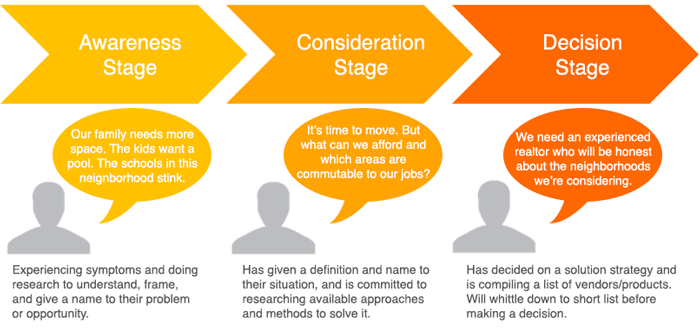Yesterday, we talked about creating better content that can be used in your email marketing strategy. Now it’s time to get into the nitty-gritty of leveraging those emails so they can actually start converting and delighting people.
The lifecycle of how a potential customer thinks and reacts to your emails is essential to pay attention to in 2016, especially if you want to increase your sales. Your emails can make a significant impression on someone new to your brand, but there’s a fine line between keeping them interested and hammering them over the head with your products or services.
And of course, there’s the fact that the process of nurturing leads should be just one part of your overall email marketing strategy. There are ways to nurture your existing customers even further down the funnel so that they become full-blown evangelists of your brand.
But for now, let’s focus on potential customers. In case you’re not familiar with the buyer’s journey or need a refresher, check out this handy chart, courtesy of HubSpot:

As you can see, there are several phases a person goes through before they decide to pull the trigger on buying something or signing up for a service. Email can help facilitate that process. But before you get to the hoped-for advocacy stage, you'll need to establish trust by using specialized and targeted content in all of your emails.
Starting Off On The Right Foot With Awarenesss
Bringing awareness about your products or services starts by tapping into consumer pain points. You can do that with your initial awareness campaign on social media or your blog, but you should continue writing about it in your initial email content.
Start by identifying these pain points (buyer personas are extremely helpful to this process), then ask yourself how your products or services can solve these problems. That’s what you should include in your emails. You'll grab subscribers’ attention once they realize you really understand what they really need.
That being said, you need to make sure the pain points you touch on are accurate. Inc. gave good tips last year on how to read your customers or leads to understand what their pains are.
Your products may have just one feature nobody else has to solve a major problem. Hone in on that for your first few emails and wrap credible stories around this theme.
Finding Ways to Use Your Products More Efficiently
Once you convert someone to buying a product or taking on a free trial, you'll want to keep sending emails that demonstrate how your products or services can work to their advantage. Even if you already provide basic manuals with your products, they may have hidden features you want your leads and customers to know about.
Those already using your products will appreciate getting these emails from you because they'll know it isn't spam. The toleration level for any type of email looking overly promotional can sometimes backfire. Providing useful tips on ways to bring more efficiency to your products or services can work on new levels in the customer lifecycle.
Some of those levels include converting your customers to buying upgrades in the near future, or converting if still using a trial version. Plus, you can demonstrate additional products or services you offer that could help solve additional problems as an effective and less obtrusive method of cross-selling.
Using Statistics to Prove Your Expertise
Before a lead gets to the decision stage—and beyond to the point where they’ll actually start promoting you—you'll want to nurture them as much trust as possible. You need to differentiate yourself from the growing list of competitors you have in your industry, especially since nearly every business employs email marketing nowadays. By providing useful statistics in your marketing emails, you can quickly rise above your competitors with your level of expertise.
Reliable comparison charts and information from experts in your industry that you offer as a goodwill gesture can also provide further purpose for your emails. These educate and prove to your audience that you stand alone in giving them something unique.
Remember that time people thought email marketing was on its way out? Well, in 2016, that couldn’t be further from the truth! That’s why it’s important to start leveraging emails as part of your marketing and sales efforts if you haven’t already, or to step up your game if you’ve been doing it for a while with little to no results.
You never know—2016 might just be your year!


